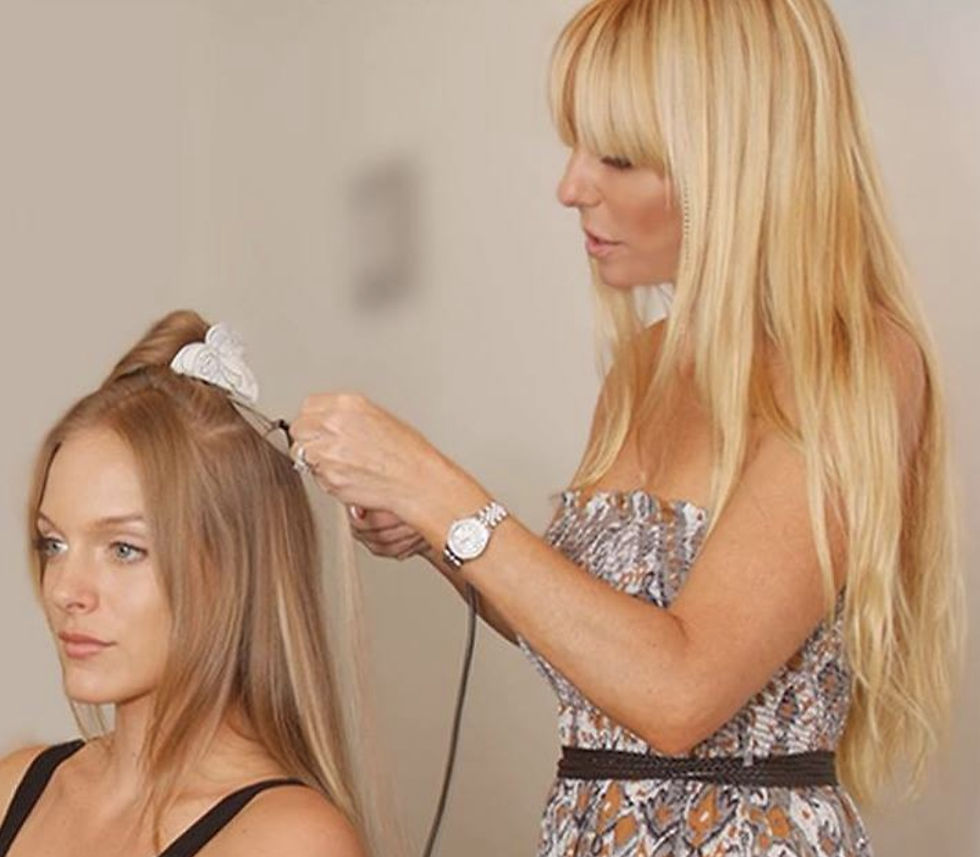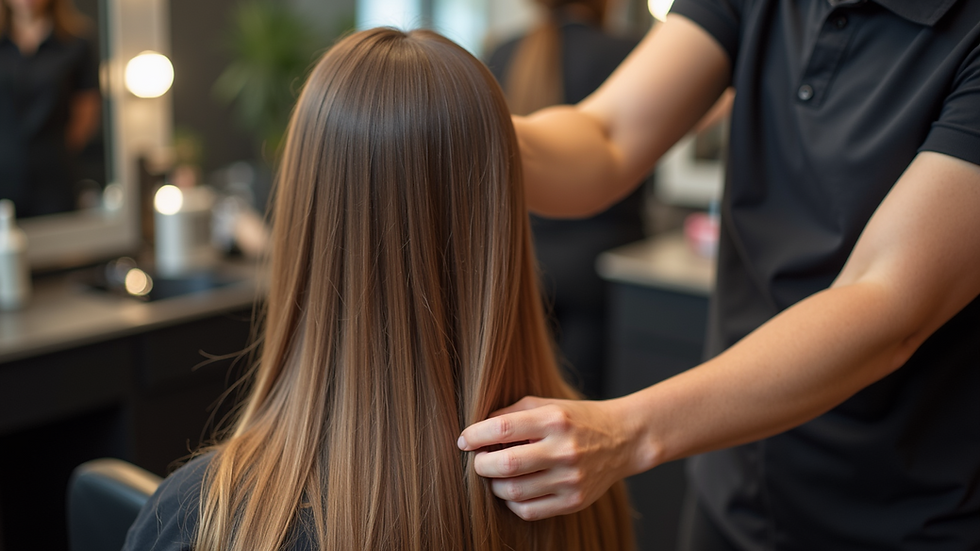What Are the Disadvantages of V-Light Extensions?
- vered valensi

- Mar 8
- 5 min read
Introduction
Brief overview of V-light extensions
Why they are popular for fine hair
Purpose of this article

Understanding V-Light Extensions
What are V-light extensions?
How they differ from traditional hair extensions
Who typically uses them?
The Disadvantages of V-Light Extensions
Fragility and Lack of Durability
More prone to breaking
Shorter lifespan compared to other methods
Limited Volume and Density
Not ideal for those seeking full, voluminous hair
May require additional extensions
Difficult Maintenance
More delicate than traditional extensions
Requires specific hair care routines
Potential for Slippage
Not as secure as other extension types
Can slip out if not properly installed or maintained
Compatibility Issues with Hair Types
Not suitable for thick or coarse hair
May not blend well with certain textures
Increased Risk of Damage to Natural Hair
Can cause stress on fine or weak hair
Improper installation may lead to breakage
Expensive Compared to Other Options
Higher initial cost
Frequent replacements add to long-term expenses
Limited Styling Options
Cannot withstand excessive heat
May not allow for certain hairstyles
Risk of Allergic Reactions
Some adhesives may cause irritation
Important to do a patch test before installation
Time-Consuming Application Process
Requires professional installation
Not a quick solution like clip-ins
Alternatives to V-Light Extensions
Nano-bond extensions for fine hair
Custom beaded wefts for durability
K-tip extensions for long-lasting wear
Final Verdict – Are V-Light Extensions Worth It?
Who should consider them?
Who should avoid them?
Conclusion
Summary of key points
Final thoughts on V-light extensions
FAQs
Do V-light extensions damage natural hair?
How long do V-light extensions last?
Are V-light extensions good for thin hair?
Can I style V-light extensions with heat?
How much do V-light extensions cost?
What Are the Disadvantages of V-Light Extensions?
Introduction
V-light extensions have gained popularity as a lightweight, natural-looking solution for adding length and volume to fine hair. They’re designed to be less bulky than traditional extensions, making them an appealing choice for those with delicate strands. But are they really the best option?
While V-light extensions have their benefits, they also come with several disadvantages that are important to consider before making a decision. This article will dive deep into the downsides of V-light extensions and explore better alternatives for those seeking a safer, more effective option.
Understanding V-Light Extensions
What Are V-Light Extensions?
V-light extensions are a type of semi-permanent hair extension designed to be lightweight and discreet. They typically use a specialized bonding method that is intended to minimize stress on fine or thin hair.
How Do They Differ from Traditional Extensions?
Unlike thicker bonded or weft extensions, V-light extensions are much smaller in size, making them less detectable. They are often marketed as a safer alternative for individuals with thin hair who struggle with heavier extension types.
Who Typically Uses Them?
Individuals with very fine or thinning hair
People looking for a natural, lightweight feel
Those who prefer semi-permanent extensions over clip-ins
The Disadvantages of V-Light Extensions
1. Fragility and Lack of Durability
One of the biggest drawbacks of V-light extensions is their fragility. Because they are designed to be ultra-lightweight, they tend to have a shorter lifespan than other types of extensions. They can easily break or shed, requiring more frequent replacements.
2. Limited Volume and Density
If you’re looking for a full, voluminous look, V-light extensions may not be the best choice. Since they are designed to be subtle and lightweight, they do not provide the same thickness as other extension methods. Many people find themselves needing additional extensions to achieve their desired look.
3. Difficult Maintenance
V-light extensions require a strict maintenance routine. Since they are delicate, they need gentle brushing, sulfate-free hair products, and extra care when washing and styling. Without proper upkeep, they can tangle or weaken over time.
4. Potential for Slippage
Because they are not as securely bonded as other types of extensions, V-light extensions can slip out more easily. This is especially true if they are not installed properly or if the wearer frequently engages in activities that involve a lot of hair movement.
5. Compatibility Issues with Hair Types
V-light extensions work best on fine hair but may not be suitable for individuals with thick, coarse, or curly hair. Those with stronger hair textures may find that these extensions do not blend well or hold up as expected.
6. Increased Risk of Damage to Natural Hair
Though they are marketed as a gentle option, V-light extensions can still cause damage. If improperly installed or removed, they can pull on natural hair, leading to thinning or breakage—especially for those with already fragile strands.
7. Expensive Compared to Other Options
V-light extensions tend to be pricier than alternatives like beaded wefts or traditional K-tips. The cost of initial installation, combined with frequent maintenance and replacement, can add up over time.
8. Limited Styling Options
Since V-light extensions are delicate, they do not hold up well under high heat. Curling irons, straighteners, and other hot styling tools may weaken the bonds or cause the extensions to shed more quickly.
9. Risk of Allergic Reactions
Some adhesives used in V-light extensions contain chemicals that may cause irritation or allergic reactions in sensitive individuals. It’s always best to do a patch test before committing to them.
10. Time-Consuming Application Process
Unlike clip-in extensions, V-light extensions require professional installation. This process can take several hours, making them a less convenient option for those seeking a quick and easy hair transformation.
Alternatives to V-Light Extensions
If V-light extensions don’t seem like the best fit for you, consider these alternatives:
Nano-bond extensions – Designed specifically for fine hair, they provide a secure hold without excessive weight.
Custom beaded wefts – These offer a more durable solution while maintaining a lightweight feel.
K-tip extensions – A long-lasting option that provides natural movement and flexibility.
Final Verdict – Are V-Light Extensions Worth It?
V-light extensions can be a good choice for those with very fine hair who prioritize a lightweight, natural appearance. However, their fragility, high maintenance requirements, and potential for slippage make them a less-than-ideal option for many people. If you want a longer-lasting, more secure alternative, nano-bonds or K-tip extensions may be a better fit.
Conclusion
While V-light extensions have their advantages, their downsides often outweigh the benefits. If you’re looking for a low-maintenance, long-lasting extension solution, exploring alternative methods may be the better choice.
FAQs
Do V-light extensions damage natural hair?Yes, they can cause damage if not installed or removed properly.
How long do V-light extensions last?Typically, 4-6 weeks with proper care.
Are V-light extensions good for thin hair?They can be, but better alternatives like nano-bonds exist.
Can I style V-light extensions with heat?Limited heat is okay, but excessive heat can weaken them.
How much do V-light extensions cost?Prices vary, but they tend to be more expensive than other extension types.



Comments